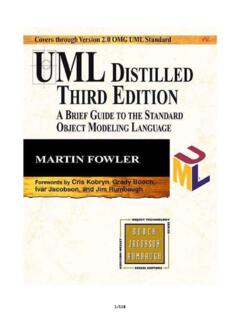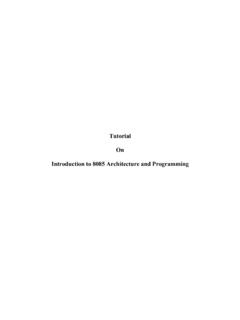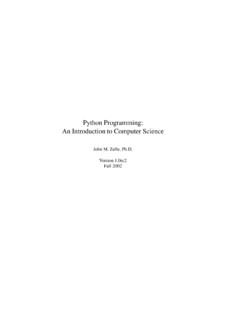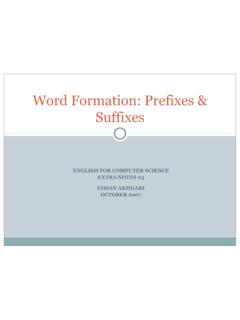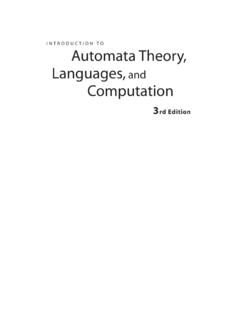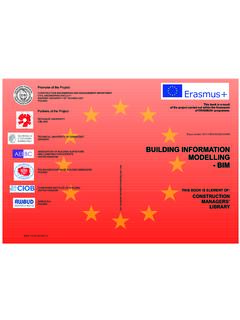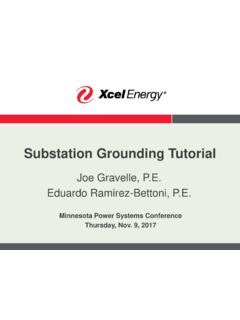Transcription of Standard Delay Format Specification - Sharif
1 1. Standard Delay Format Specification Version May 1995. Open Verilog international Contents 1 Introduction Introduction .. 1-1. Introduction to Version .. 1-1. Published by OVI .. 1-2. Acknowledgements.. 1-3. Version History .. 1-4. Version - June, 1993 .. 1-4. Version - February, 1994 .. 1-4. Correction to Version - July, 1994 .. 1-5. Version - April, 1995 .. 1-5. 2 SDF in the Design Process SDF in the Design Process.. 2-1. Sharing of Timing Data .. 2-1. Using Multiple SDF Files in One Design .. 2-1. Timing Data and Constraints .. 2-1. Timing Environment .. 2-1. Back-Annotation of Timing Data for Design Analysis .. 2-2. The Timing Calculator .. 2-2. The Annotator .. 2-3. Consistency Between SDF File and Design Description .. 2-4. Consistency Between SDF File and Timing Models .. 2-4. Forward-Annotation of Timing Constraints for Design Synthesis .. 2-5. Timing Models Supported by SDF.. 2-7. Modeling Circuit Delays.
2 2-7. Modeling Output Pulse Propagation .. 2-7. Modeling Timing Checks .. 2-8. Modeling Interconnect Delays .. 2-8. Using Internal Nodes .. 2-8. 3 Using the Standard Delay Format SDF File Content .. 3-1. Header Section .. 3-3. SDF Version Entry.. 3-3. Design Name Entry .. 3-4. May 1995 i Date Entry .. 3-4. Vendor Entry .. 3-4. Program Name Entry.. 3-5. Program Version Entry .. 3-5. Hierarchy Divider Entry .. 3-5. Voltage Entry.. 3-6. Process Entry .. 3-6. Temperature Entry .. 3-6. Timescale Entry.. 3-7. Cell Entries .. 3-8. Cell Type Entry .. 3-8. Cell Instance Entry .. 3-9. Timing Specifications .. 3-11. Delay Entries.. 3-12. PATHPULSE .. 3-12. PATHPULSEPERCENT .. 3-14. ABSOLUTE Delays .. 3-15. INCREMENT Delays .. 3-15. Delay Definition Entries.. 3-16. Specifying Delay Values .. 3-16. Input/Output Path Delays .. 3-19. Conditional Path Delays .. 3-19. Condition Labels .. 3-20. Output Retain Delays .. 3-21. Port Delays.
3 3-22. Interconnect Delays.. 3-22. Device Delays .. 3-23. Timing Check Entries.. 3-26. Timing Checks .. 3-26. Conditional Timing Checks .. 3-26. Edge Specifications.. 3-28. Specifying Timing Check Limit Values .. 3-28. Setup Timing Check .. 3-29. Hold Timing Check .. 3-29. SetupHold Timing Check.. 3-30. Recovery Timing Check .. 3-31. Removal Timing Check .. 3-32. Recovery/Removal Timing Check .. 3-32. Skew Timing Check.. 3-33. Width Timing Check .. 3-33. Period Timing Check .. 3-34. No Change Timing Check .. 3-35. Timing Environment Entries .. 3-36. Constraints .. 3-36. Path Constraint .. 3-36. Period Constraint.. 3-37. ii May 1995. Sum Constraint .. 3-38. Diff Constraint .. 3-39. Skew Constraint .. 3-39. Timing Environment .. 3-40. Arrival Environment .. 3-40. Departure Environment .. 3-41. Slack Environment.. 3-42. Waveform Environment .. 3-43. 4 Syntax of SDF. SDF File Characters .. 4-1. SDF Characters .. 4-1.
4 Comments .. 4-1. Syntax Conventions .. 4-2. Notation .. 4-2. Variables .. 4-2. SDF File Syntax .. 4-4. Cell Entries .. 4-5. Timing Specifications.. 4-5. Data Values .. 4-7. Conditions for Path Delays .. 4-9. Conditions for Timing Checks .. 4-9. Constants for Expressions.. 4-9. Operators for Expressions.. 4-10. Operation of SDF Equality Operators .. 4-11. Precedence Rules of SDF Operators .. 4-11. 5 SDF File Examples SDF File Example 1 .. 5-1. SDF File Example 2 .. 5-3. SDF File Example 3 .. 5-5. SDF File Example 4 .. 5-6. 6 Delay Model Recommendation Introduction .. 6-1. The Delay Model .. 6-2. Timing Objects .. 6-2. Rules .. 6-3. 7 Index .. index-i May 1995 iii iv May 1995. 1. Introduction Introduction Acknowledgements Version History Introduction Introduction The Standard Delay Format (SDF) file stores the timing data generated by EDA tools for use at any stage in the design process. The data in the SDF. file is represented in a tool-independent way and can include Delays: module path, device, interconnect, and port Timing checks: setup, hold, recovery, removal, skew, width, period, and nochange Timing constraints: path, skew, period, sum, and diff Timing environment: intended operating timing environment Incremental and absolute delays Conditional and unconditional module path delays and timing checks Design/instance-specific or type/library-specific data Scaling, environmental, and technology parameters Throughout a design process, you can use several different SDF files.
5 Some of these files can contain pre-layout timing data. Others can contain path constraint or post-layout timing data. The name of each SDF file is determined by the EDA tool. There are no conventions for naming SDF files. Introduction to Version of the Standard Delay Format includes many enhancements Version for the Specification of the environment in which a circuit is operating with regard to timing. Along with existing and new constraint information, this makes the Format much more useful for communication between timing analysis and synthesis tools. Some new constructs and enhancements for the back-annotation of computed timing data are also included. For example, the removal . timing check bears the same relationship to a recovery check as the hold check does to a setup check. Note that some of the new constructs anticipate corresponding enhancements to popular analysis tools. Many SDF files written to the Specification will also conform to the version (with the adjustment of the SDFVERSION entry).
6 However, some significant changes in the area of constraints and the less frequently used back-annotation constructs mean that the new Format is not 100%. backward-compatible. File readers should use the SDFVERSION entry if they are unable to adapt to the differences automatically. See the version history later in this chapter for complete information about changes. May 1995 1-1. Introduction OVI has developed this SDF Specification to enable accurate and Published by OVI. unambiguous transfer of Delay data between tools that require timing. All parties utilizing the SDF should interpret and manipulate Delay data according to this Specification . The Specification will be provided free of charge to all interested members of OVI. ASIC Vendors and 3rd party tool suppliers that desire copies of the SDF Specification should request it from the OVI headquarters. Please direct your requests to: Lynn Horobin Open Verilog international 15466 Los Gatos Blvd.
7 , Suite 109-071, Los Gatos, CA 95032. Tel: (408) 353-8899. Fax: (408) 353-8869. internet e-mail: Open Verilog international makes no warranties whatsoever with respect to the completeness, accuracy, or applicability of the information in this document to a user's requirements. Open Verilog international reserves the right to make changes to the Standard Delay Format Specification at any time without notice. Open Verilog international does not endorse any particular CAE tool that is based on the Verilog hardware description language. 1-2 Introduction Acknowledgements Acknowledgements The OVI Logic Modeling Technical SubCommittee acknowledges the individual and team efforts invested in establishing this version of the SDF. Specification : Brien Anderson (Acuson). Tim Ayres (Zycad). Bruce Bandali (LSI Logic). John Busco (Toshiba). Irene Chang (Mitsubishi). Shir-Shen Chang (Synopsys). Graham Davies (Viewlogic). Ted Elkind (Cadence).
8 Vassilios Gerousis (Motorola). Hector Lai (Quad Design). Jimmy Lin (Toshiba). Liren Liu (Actel). Ying-li Ren (Lattice). Steven Sliman (Texas Instruments). Hoanh Tran (Toshiba). May 1995 1-3. Version History Version History Version - The keywords, USERDEF and INCLUDE, which were in version , are no June, 1993 longer supported by OVI SDF Hierarchy divider character restricted to period (.) or slash (/). Use of COND keyword with timing checks revised and timing_check_condition restricted for correspondence with the Verilog language. CORRELATION construct added to CELL. C and C++ style comments now allowed in SDF files. Alterations to all examples of the RECOVERY timing check, unfortunately resulting in them being incorrect in version of the Specification , see version , below. WIDTH and PERIOD construct descriptions corrected - width and period timing checks are for minimum allowable pulse width and period, not maximum.
9 All Delay constructs (IOPATH, DEVICE, PORT, INTERCONNECT and NETDELAY) changed to permit negative values instead of only positive, value changed to rvalue in formal syntax descriptions involving these keywords. Corrections to TIMINGCHECK entries in Example 2 of Section 2. Other minor changes to descriptive text. Version - Formal syntax description consolidated in new chapter, BNF symbols value February, 1994 and exp_list deleted, absvals and incvals both replaced by del_def, some symbols changed for more intuitive reading, other minor corrections and reorganizations. The SDFVERSION entry in the header is now required. Other entries in the header are still optional, but, if present, must now contain data ( empty . entries such as (DESIGN ) are no longer allowed). The use of the wildcard instance Specification restricted to cells at the ASIC. physical primitive level, no longer allowed in PATH or port_path. Description of CORRELATION entry expanded and syntax revised to avoid possible confusion with min:typ:max triples.
10 CELL entries may now have zero or more timing_specs (previously one or more), allowing CELL entries to carry a CORRELATION entry without other timing data. The option to provide a single value or a min:typ:max triple has been made available uniformly to all constructs. However, it is now prohibited to mix single values and triples in the same SDF file. The semantics of Delay values (rvalues) in an rvalue_list (formerly rvalue). has been defined for lists of length 1, 2, 3, 6 or 12. Provision is made for omitting rvalues from the ends of lists of 6 and 12. Any rvalue can be null. 1-4 Introduction Version History PATHPULSE and GLOBALPATHPULSE changed to allow Specification of both ports of a path or neither, the latter applying to all paths across the cell. Improved description of use of port_instance Specification in DEVICE. entries to apply delays to paths ending at a particular output port. timing_check_condition now allows only ~ and !
